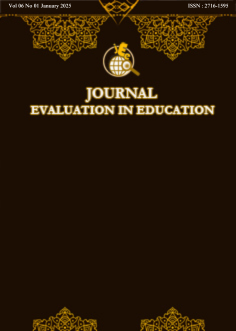Numeracy and Environmental Awareness Attitudes of Primary School-Age Children in the Malind Community
Abstract
Purpose of the study: This study examines students' numeracy abilities and attitudes toward environmental awareness among primary school-age children. Through an in-depth understanding of these two aspects, this study aims to provide a strong foundation for formulating appropriate solutions and learning methods that align with the needs and conditions of primary school-age children.
Methodology: This research employed a descriptive method with a quantitative approach to explore numeracy literacy capabilities and attitudes toward environmental awareness. The descriptive research design was structured to provide detailed descriptions of the conditions or characteristics of the phenomena under study, focusing on "how" questions and presenting facts accurately and comprehensively.
Main Findings: The results indicated that 57.5% of primary school-age children demonstrated moderate numeracy skills, while 32.5% fell into the poor category. This suggests the need for educational intervention to enhance numeracy capabilities. Additionally, children's environmental awareness attitudes largely fell into the good category at 65%. However, certain environmental awareness attitudes still require additional attention for optimal development. Systematic efforts remain necessary to improve both aspects.
Novelty/Originality of this study: This study provides novel insights into numeracy capabilities and environmental awareness attitudes among primary school-age children from the Malind community in EswambiVillage. The data offers contextual and specific information regarding educational conditions and environmental awareness in this region, which has yet to be extensively studied in previous research.
References
P. Bonifacci, D. Compiani, A. Affranti, and B. Peri, “Home literacy and numeracy interact and mediate the relationship between socio-economic status and early linguistic and numeracy skills in preschoolers,” Front. Psychol., vol. 12, no. September, 2021, doi: 10.3389/fpsyg.2021.662265.
S. Reder, B. Gauly, and C. Lechner, “Practice makes perfect: Practice engagement theory and the development of adult literacy and numeracy proficiency,” Int. Rev. Educ., vol. 66, no. 2–3, pp. 267–288, 2020, doi: 10.1007/s11159-020-09830-5.
M. F. Bell et al., “Numeracy and literacy attainment of children exposed to maternal incarceration and other adversities: A linked data study,” J. Sch. Psychol., vol. 100, no. August, p. 101241, 2023, doi: 10.1016/j.jsp.2023.101241.
D. Silva, L. Colvin, R. Glauert, F. Stanley, R. Srinivasjois, and C. Bower, “Literacy and numeracy underachievement in boys and girls with ADHD,” J. Atten. Disord., vol. 24, no. 9, pp. 1305–1316, 2020, doi: 10.1177/1087054715596575.
M. Sufianti and Nurdyansyah, “Calistung E-Module innovation for strengthening basic literacy and numeracy student,” J. Ilm. Sekol. Dasar, vol. 7, no. 2, pp. 236–248, 2023, doi: 10.23887/jisd.v7i2.55833.
N. Imjai, S. Aujirapongpan, and Z. Yaacob, “Impact of logical thinking skills and digital literacy on Thailand’s generation Z accounting students’ internship effectiveness: Role of self-learning capability,” Int. J. Educ. Res. Open, vol. 6, no. January, p. 100329, 2024, doi: 10.1016/j.ijedro.2024.100329.
Y. Wahyu, I. W. Suastra, I. W. Sadia, and N. K. Suarni, “The effectiveness of mobile augmented reality assisted STEM-based learning on scientific literacy and students’ achievement,” Int. J. Instr., vol. 13, no. 3, pp. 343–356, 2020, doi: 10.29333/iji.2020.13324a.
L. Ke, T. D. Sadler, L. Zangori, and P. J. Friedrichsen, “Developing and using multiple models to promote scientific literacy in the context of socio-scientific issues,” Sci. Educ., vol. 30, no. 3, pp. 589–607, 2021, doi: 10.1007/s11191-021-00206-1.
L. Latifah and F. P. Rahmawati, “Penerapan program CALISTUNG untuk meningkatkan literasi numerasi siswa kelas rendah di sekolah dasar [Implementation of the CALISTUNG program to improve numeracy literacy of lower grade students in elementary schools],” J. Basicedu, vol. 6, no. 3, pp. 5021–5029, 2022, doi: 10.31004/basicedu.v6i3.3003.
S. P. Sari, D. A. Natuna, and A. Afrianto, “Pengaruh kecerdasan emosional dan literasi numerasi terhadap kompetensi pedagogik guru matematika sekolah menengah pertama (smp) negeri Kota Pekanbaru [The influence of emotional intelligence and numeracy literacy on the pedagogical competence of junior high school mathematics teachers in Pekanbaru City],” J. PAJAR (Pendidikan dan Pengajaran), vol. 6, no. 1, p. 290, 2022, doi: 10.33578/pjr.v6i1.8379.
C. M. Lechner, B. Gauly, A. Miyamoto, and A. Wicht, “Stability and change in adults’ literacy and numeracy skills: Evidence from two large-scale panel studies,” Pers. Individ. Dif., vol. 180, p. 110990, 2021, doi: 10.1016/j.paid.2021.110990.
S. Winarni, A. Kumalasari, M. Marlina, and R. Rohati, “Efektivitas video pembelajaran matematika untuk mendukung kemampuan literasi numerasi dan digital siswa [The effectiveness of mathematics learning videos to support students' numeracy and digital literacy skills],” AKSIOMA J. Progr. Stud. Pendidik. Mat., vol. 10, no. 2, p. 574, 2021, doi: 10.24127/ajpm.v10i2.3345.
A. Qodriyanti, H. N. Yarza, I. Irdalisa, M. Elvianasti, and R. F. Ritonga, “Analisis sikap peduli lingkungan siswa di salah satu MAN pada materi pelestarian lingkungan [Analysis of students' environmental care attitudes at one of the MANs on environmental conservation material],” J. Eksakta Pendidik., vol. 6, no. 1, pp. 111–116, 2022, doi: 10.24036/jep/vol6-iss1/643.
D. S. Triani, E. W. Winarni, and A. Muktadir, “Pengaruh model pembelajaran problem based learning (PBL) terhadap sikap peduli lingkungan dan hasil belajar IPA siswa kelas IV SDN 78 Kota Bengkulu [The influence of the problem based learning (PBL) learning model on environmental awareness attitudes and science learning outcomes of grade IV students at SDN 78 Bengkulu City],” J. Pembelajaran dan Pengajaran Pendidik. Dasar, vol. 2, no. 1, pp. 13–21, 2019, doi: 10.33369/dikdas.v2i1.8677.
U. N. Rokhmah and M. Munir, “Implementasi budaya sekolah berwawasan lingkungan dalam membentuk karakter peduli lingkungan siswa sekolah dasar [Implementation of environmentally aware school culture in forming environmentally conscious character of elementary school students],” Muallimuna J. Madrasah Ibtidaiyah, vol. 7, no. 1, p. 63, 2021, doi: 10.31602/muallimuna.v7i1.5314.
A. N. Pratiwi and I. Rohman, “Integrasi nilai akhlak pada materi usaha pelestarian lingkungan dalam pembelajaran tematik sekolah dasar [Integration of moral values into environmental conservation efforts in elementary school thematic learning],” J. Basicedu, vol. 6, no. 5, pp. 8635–8640, 2022, doi: 10.31004/basicedu.v6i5.3859.
E. Rosdiana and E. Surya, “Model pembelajaran SETS (Science, Environmental, Technology, Society) berbasis budaya lokal pada pembelajaran ipa terhadap berfikir kritis dan peduli lingkungan [The SETS (Science, Environmental, Technology, Society) learning model based on local culture in science learning towards critical thinking and environmental care],” Sch. Educ. J. Pgsd Fip Unimed, vol. 12, no. 1, pp. 1–7, 2022, doi: 10.24114/sejpgsd.v12i1.34816.
B. D. Immaniar, S. Sumarmi, and I. K. Astina, “Pembelajaran lingkungan berbasis kearifan lokal dengan model experiential learning [Environmental learning based on local wisdom with an experiential learning model],” J. Pendidik. Teor. Penelitian, dan Pengemb., vol. 4, no. 5, p. 648, 2019, doi: 10.17977/jptpp.v4i5.12431.
N. N. Rediani, “Exploring the world of numeracy: An analysis of third-grade elementary school students,” Int. J. Elem. Educ., vol. 8, no. 1, pp. 39–46, 2024, doi: 10.23887/ijee.v8i1.68455.
B. A. Putri, D. P. Utomo, and Z. Zukhrufurrohmah, “Analisis kemampuan literasi numerasi peserta didik smp dalam menyelesaikan soal cerita aljabar [Analysis of junior high school students' numeracy literacy skills in solving algebra story problems],” JRPM (Jurnal Rev. Pembelajaran Mat., vol. 6, no. 2, pp. 141–153, 2021, doi: 10.15642/jrpm.2021.6.2.141-153.
S. Khoirunnisa and A. G. Adirakasiwi, “Analisis kemampuan literasi numerasi siswa smp pada era merdeka belajar [Analysis of junior high school students' numeracy literacy skills in the era of independent learning],” J. Pembelajaran Mat. Inov., vol. 6, no. 3, pp. 925–936, 2023, doi: 10.22460/jpmi.v6i3.17393.
S. A. Pulungan, “Analisis kemampuan literasi numerasi pada materi persamaan linear siswa SMP PAB 2 Helvetia [Analysis of numeracy literacy skills in linear equation material of SMP PAB 2 Helvetia students],” J. Teach. Educ., vol. 3, no. 3, pp. 266–274, 2022.
S. S. Atsilnaura, A. Trisiana, and E. B. Prihastari, “Analisis kemampuan literasi numerasi pada mata pelajaran matematika siswa kelas I SD N 3 Punung Tahun Ajaran 2022/2023 [Analysis of numeracy literacy skills in mathematics subjects of grade I students of SD N 3 Punung in the 2022/2023 academic year],” J. Pendidik. Tambusai, vol. 8, pp. 12290–12295, 2024, doi: 10.31004/jptam.v8i1.14261.
M. Musdalifa, N. Nasrah, and A. Anisa, “Analisis sikap peduli lingkungan siswa melalui program adiwiyata di UPT SD Inpres Bisara [Analysis of students' environmental care attitudes through the Adiwiyata program at UPT SD Inpres Bisara],” J. Educ., vol. 6, no. 4, pp. 20795–20805, 2024, doi: 10.31004/joe.v6i4.6197.
R. Anilia, “Analisis sikap peduli lingkungan sebagai sumber belajar siswa kelas III SD Negeri 11 Tanjung Sakti Pumu [Analysis of environmental care attitudes as a learning resource for grade III students of SD Negeri 11 Tanjung Sakti Pumu],” J. Soc. Sci. Res., vol. 3, no. 2, pp. 11939–11948, 2023.
Y. Nurmalasari and R. Erdiantoro, “Perencanaan dan keputusan karier: Konsep krusial dalam layanan BK Karier [Career planning and decisions: A crucial concept in Career Guidance and Counseling services],” Quanta, vol. 4, no. 1, pp. 44–51, 2020, doi: 10.22460/q.v1i1p1-10.497.
C. Virgiawan, “Studi Keanekaragaman Capung (Odonata) Sebagai Bioindikator Kualitas Air Sungai Brantas Batu-Malang Dan Sumber Belajar Biologi,” JPBI (Jurnal Pendidik. Biol. Indones., vol. 1, no. 2, pp. 188–196, 2016, doi: 10.22219/jpbi.v1i2.3330.
W. Ningsih, Asmidaryani, and Emirawati, “Tantangan dan kesulitan guru, orang tua dan siswa dalam pelaksanaan pembelajaran tatap muka pada era new normal pandemi Covid-19 [Challenges and difficulties for teachers, parents and students in implementing face-to-face learning in the new normal era of the Covid-19 pandemic],” Al-Mafahim J. Pendidik. Guru Madrasah Ibtidaiyah, vol. 5, no. 1, pp. 1–7, 2022, doi: 10.53398/jm.v5i1.116.
E. Emzir, Metodologi Penelitian Pendidikan: Kuantitatif dan Kualitatif [Educational Research Methodology: Quantitative and Qualitative]. jakarta: PT Raja Grafindo Persada, 2008.
S. Sudaryono, Metode Penelitian Pendidikan [Educational Research Methods]. jakarta: Prenamedia Group, 2015.
G. Agung, Metodelogi Penelitian Pendidikan [Educational Research Methodology]. Malang: Aditya Media Publishing, 2014.
M. Yusuf, Asessmen dan Evaluasi Pendidikan [Educational Assessment and Evaluation]. Jakarta: Prenadamedia Group, 2015.
M. Bisri, H., & Ichsan, “Penilaian otentik dengan teknik nontes di sekolah dasar [Authentic assessment with non-test techniques in elementary schools],” J. Sos. Hum., vol. 6, no. 2, pp. 81–93, 2015, doi: 10.30997/jsh.v6i2.503.
T. Tohirin, Metode Penelitian Kualitatif Dalam Pendidikan Dan Bimbingan Konseling [Qualitative Research Methods in Education and Counseling Guidance]. Jakarta: PT Raja Grafindo Persada, 2012.
J. Jumasih, “Literature study : The influence of learning interest on student achievement,” Humanis, vol. 4, no. 1, pp. 1386–1392, 2023, doi: 10.58258/jime.v10i2.6761.
H. ‘Adila Kartika and Susanto, “Analysis of discipline character and learning interest on student learning outcomes,” DIAJAR J. Pendidik. dan Pembelajaran, vol. 3, no. 1, pp. 148–154, 2024, doi: 10.54259/diajar.v3i1.2403.
Y. D. Puspitarini and M. Hanif, “Using learning media to increase learning motivation in elementary school,” Anatol. J. Educ., vol. 4, no. 2, pp. 53–60, 2019, doi: 10.29333/aje.2019.426a.
A. Ariadi, N. Iman, A. D. Saputro, and S. D. Laksana, “Improving students’ interest in learning through various creative methods at madrasah ibtida’iyah ( Islamic Elementary School ) PAS Baitul Qur’an Gontor Ponorogo,” J. Res. Islam. Educ., vol. 3, no. 2, pp. 1–11, 2021, doi: 10.25217/jrie.v3i2.2031.
S. D. Mardianti, “Factors of decreasing students interest when learning from home,” ETUDE J. Educ. Res., vol. 1, no. 2, pp. 61–67, 2021, doi: 10.56724/etude.v1i2.28.
L. M. Cronin-Golomb and P. J. Bauer, “Self-motivated and directed learning across the lifespan,” Acta Psychol. (Amst)., vol. 232, no. August 2022, p. 103816, 2023, doi: 10.1016/j.actpsy.2022.103816.
N. Khotmi et al., “The factors that cause low interest in learning in grade 4 students at SDN 3 Perian,” J. Ilm. Mandala Educ., vol. 10, no. 1, pp. 2442–9511, 2024, doi: 10.58258/jime.v9i1.6761/http.
S. T. Rahmat, S. Muslim, R. Situmorang, M. Sukardjo, and Ferdina, The Importance of Developing Learning Resource Centers to Improve the Quality of Learning in Remote, Disadvantaged, Leading Areas, vol. 1, no. 19. Atlantis Press SARL, 2023. doi: 10.2991/978-2-38476-022-0_85.
I. S. Widodo, A. Atiqoh, and Y. Wiyarno, “Effects of online and offline learning and interest learning on learning outcomes,” J. Educ., vol. 05, no. 03, pp. 9952–9964, 2023.
Aditya Hartini and Siti Faridah, “Factors causing low interest in learning science in elementary schools,” J. Sustain. Dev. Sci., vol. 4, no. 2, pp. 37–41, 2022, doi: 10.46650/jsds.4.2.1334.37-41.
E. C. J. Roefs, I. E. Oosterheert, Y. A. M. Leeman, W. M. van der Veld, and P. C. Meijer, “Secondary teachers’ experiences of presence in teaching: A large-scale investigation using narrative vignettes,” Teach. Teach. Educ., vol. 146, pp. 104642, 2024, doi: 10.1016/j.tate.2024.104642.
A. Asnita and K. Kasmawati, “Pengaruh tingkat ekonomi orang tua terhadap minat melanjutkan pendidikan ke perguruan tinggi pada siswa kelas xii Sma Negeri 12 Sinjai Kabupaten Sinjai [The influence of parents' economic level on the interest in continuing education to college in class XII students of Sma Negeri 12 Sinjai, Sinjai Regency],” Educ. Leadersh. J. Manaj. Pendidik., vol. 2, no. 2, pp. 179–189, 2023, doi: 10.24252/edu.v2i2.33373.
S. Sodikin, “The influence of parents economic level and motivation on mathematics learning outcomes,” Mathline J. Mat. dan Pendidik. Mat., vol. 8, no. 4, pp. 1373–1382, 2023, doi: 10.31943/mathline.v8i4.332.
A. D. Mega, “The influence of parents’ socio-economic status and student learning outcomes on students’ economic literacy level,” Econ. Bus. Manag. J., vol. 1, no. 1, pp. 1–7, 2022.
A. P. Tjilen and N. N. Rediani, “Educational assessment: Parental economics and the high incidence of learning loss,” Indones. J. Educ. Res. Rev., vol. 6, no. 3, pp. 501–510, 2023, doi: 10.23887/ijerr.v6i3.68656.
C. A. Islamey, S. Faradina, A. Sulistyani, and I. D. Kumala, “Pengaruh episodic future thinking terhadap sikap peduli lingkungan [The influence of episodic future thinking on environmental concern attitudes],” Gadjah Mada J. Prof. Psychol., vol. 9, no. 2, p. 233, 2023, doi: 10.22146/gamajpp.82093.
S. E. Damayanti and S. Komsiah, “Pengaruh konten media sosial terhadap sikap peduli lingkungan [The influence of social media content on environmental attitudes],” Ikraith Hum., vol. 8, no. 1, pp. 241–223, 2024, doi: 10.37817/ikraith-humaniora.v8i1.
F. Mariza, R. Sahputra, and I. Lestari, “Pengaruh pembelajaran berbasis lingkungan terhadap sikap pelestarian lingkungan pada materi pencemaran lingkungan [The influence of environmental-based learning on environmental conservation attitudes in environmental pollution material],” J. Ris. Fis. Edukasi dan Sains, vol. 8, no. 1, pp. 1–7, 2021, doi: 10.22202/jrfes.2021.v8i1.4570.
Nurfadilah, M. D. Tanamir, and L. Setriani, “Pengaruh P5 gaya hidup berkelanjutan dalam meningkatkan sikap peduli lingkungan siswa fase e di SMA Negeri 1 Rao Utara Kabupaten Pasaman [The influence of P5 sustainable lifestyle in improving the environmental awareness of students in phase e at SMA Negeri 1 Rao Utara, Pasaman Regency],” Educ. Indones. Res. J. Educ., vol. 4, no. 2, pp. 884–889, 2024, doi: 10.31004/irje.v4i2.744.
F. Lubis, H. Febriani, and Rohani, “Pengaruh model pembelajaran meaningful instructional design (mid) terhadap hasil belajar dan sikap peduli lingkungan siswa pada materi limbah dan daur ulang di kelas X SMA Swasta Al-Hikmah Medan [The influence of the meaningful instructional design (MID) learning model on students' learning outcomes and environmental awareness attitudes on waste and recycling material in class X of Al-Hikmah Private High School, Medan],” Marga J. Innov. Creat., vol. 1, no. 2, pp. 76–83, 2024.
D. Handayani and W. Sopandi, “Penggunaan model problem based learning untuk meningkatkan kemampuan memecahkan masalah dan sikap peduli lingkungan peserta didik [The use of problem based learning models to improve students' problem solving skills and environmental awareness.],” EduHumaniora | J. Pendidik. Dasar Kampus Cibiru, vol. 7, no. 2, p. 105, 2016, doi: 10.17509/eh.v7i2.2702.
A. A. Yusuf, E. S. Sahabuddin, and S. D, “Pengaruh model pembelajaran problem based learning melalui kegiatan membuat bottle craft untuk meningkatkan kesadaran peduli lingkungan siswa kelas IV SD [The influence of the problem based learning model through bottle craft making activities to increase environmental awareness of fourth grade elementary school students],” J. Metaf. Pendidik., vol. 1, no. 2, pp. 202–211, 2023.
W. S. Nugraha and A. Rachmawati, “Pengaruh media animasi terhadap karakter peduli lingkungan siswa sd kelas 3 pada pembelajaran IPA [The influence of animation media on the environmental care character of grade 3 elementary school students in science learning],” Kalam Cendekia J. Ilm. Kependidikan, vol. 11, no. 3, 2023, doi: 10.20961/jkc.v11i3.81583.
C. Talakua and C. V. Maitimu, “Efektifitas media pembelajaran berbasis smartphone untuk mengembangkan sikap peduli lingkungan peserta didik [The effectiveness of smartphone-based learning media in developing students' environmental awareness attitudes],” Biodik, vol. 6, no. 3, pp. 392–401, 2020, doi: 10.22437/bio.v6i3.10006.
Copyright (c) 2025 Ni Nyoman Rediani, Trinovianto G.R Hallatu, Ivylentine Datu Palittin, Hanova Rani E. Retnaningtyas, Herrio Tekdi Nainggolan, Sunarni Sunarni, Yus Witdarko, Yusri Yusri

This work is licensed under a Creative Commons Attribution 4.0 International License.
Authors who publish with this journal agree to the following terms:
- Authors retain copyright and acknowledge that the Integrated Science Education Journal is the first publisher licensed under a Creative Commons Attribution 4.0 International License.
- Authors are able to enter into separate, additional contractual arrangements for the non-exclusive distribution of the journal's published version of the work (e.g., post it to an institutional repository or publish it in a book), with an acknowledgment of its initial publication in this journal.
- Authors are permitted and encouraged to post their work online (e.g., in institutional repositories or on their website) prior to and during the submission process, as it can lead to productive exchanges and earlier and greater citation of published work.









.png)
.png)





